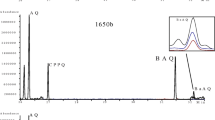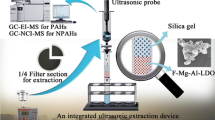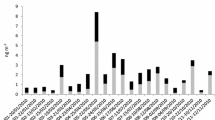Abstract
We have assessed and compared the extraction recoveries of polycyclic aromatic hydrocarbons (PAHs) with molecular weights of 252, 276, 278, 300 and 302 from diesel particulate matter (PM) and urban air particles using ultrasonically assisted extraction and accelerated solvent extraction methods, and evaluated the effects of sample and treatment parameters. The results show that accelerated solvent extraction can extract PAHs more efficiently from diesel PM than ultrasonically assisted extraction. They also show that PAHs are more difficult to extract from diesel PM than from urban air particles. Using toluene and maximum instrumental settings (200 °C, 3,000 psi and five extraction cycles) with 30-min static extraction times > 85% of the analytes were estimated to be extracted from the diesel particles, but four extraction cycles with just 5-min static extraction times under these conditions seem to be sufficient to extract > 95% of the analytes from the urban air particles. The accelerated solvent extraction method was validated using the Standard Reference Materials (SRM) 1649a, Urban Dust, and SRM 2975 and SRM 1650a, Diesel Particulate Matter, from the US National Institute of Standards and Technology (NIST). PAH concentrations determined by on-line high-performance liquid chromatography–gas chromatography–mass spectrometry (HPLC-GC-MS) following the developed accelerated solvent extraction method were generally higher than the certified and reference NIST values and concentrations reported in the literature (e.g. the estimated concentration of benzo[a]pyrene in SRM 2975 was 15-fold higher than the NIST-certified value), probably because the extraction recoveries were higher than in previous studies. The developed accelerated solvent extraction method was used to analyse high molecular (HMW) weight PAHs (MW > 302) in the investigated SRMs, and more than 170 (SRM 1649a), 80 (SRM 1650b) and 60 (SRM 2975) potential high molecular weight PAHs were tentatively identified in them, with molecular weights (depending on the SRM sample analysed) of 316, 326, 328, 340, 342, 350, 352, 366, 374 and 376. This is, to our knowledge, the first study to tentatively report PAHs with molecular weights of 316, 326, 328, 342, 350, 352, 366 and 376 in diesel particulate matter. GC-MS chromatograms obtained in selected ion monitoring mode (extracted ions for the abovementioned m/z) and full-scan mass spectra of tentatively identified high molecular weight PAHs are shown in the Electronic supplementary material.

Similar content being viewed by others
References
Sehlstedt M, Forsberg B, Westerholm R, Boman C, Sandström T (2007) The role of particle size and chemical composition for health risks of exposure to traffic related aerosols - a review of the current literature, Swedish road administration report. http://www.vv.se/fudinfoexternwebb/pages/PublikationVisa.aspx?PublikationId=310. Accessed 16 May 2008
Bernstein J, Alexis N, Barnes C, Bernstein I, Nel A, Peden D, Diaz-Sanches D, Tarlo S, Williams P (2004) J Allergy Clin Immunol 114:1116–1123
Künzli N, Kaiser R, Medina S, Studnicka M, Chanel O, Filliger P, Herry M, Horak Jr F, Puybonnieux-Texier V, Quénel P, Schneider J, Seethaler R, Vergnaud J-C, Sommer H (2000) Lancet 356:795–801
Peters A, Dockery D, Muller J, Mittleman M (2001) Circulation 103:2810–2815
Rojas-Martinez R, Perez-Padilla R, Olaiz-Fernandez G, Mendoza-Alvarado L, Moreno-Macias H, Fortoul T, McDonnell W, Loomis D, Romieu I (2007) Am J Respir Crit Care Med 176:377–384
Pope C, Burnett R, Thun M, Calle E, Krewski D, Ito K, Thurston G (2002) JAMA 287:1132–1141
Brunekreef B, Holgate S (2002) Lancet 360:1233–1242
Commission of the European Communities (2005) Commission staff working paper, annex to the communication on thematic strategy on air pollution and the directive on ambient air quality and cleaner air for Europe, impact assessment, Brussels, September 2005. http://ec.europa.eu/environment/archives/air/cafe/pdf/ia_report_en050921_final.pdf Accessed 16 May 2008
Diaz-Sanchez D, Riedl M (2005) Am J Physiol Lung Cell Mol Physiol 289:722–723
Sydbom A, Blomberg A, Parnia S, Stenfors N, Sandström T, Dahlén S-E (2001) Eur Respir J 17:733–746
Mauderly J (2001) Toxicol Sci 62:6–9
US Environmental Protection Agency (EPA) (2002) Health assessment document for diesel engine exhaust, prepared by the National Center for Environmental Assessment, Washington DC, for the Office of Transportation and Air Quality, EPA/600/8-90/057F. Available from the National Technical Information Service, Springfield, VA, PB2002-107661 and http://www.epa.gov/ncea
Singh P, DeMarini D, Dick C, Tabor D, Ryan J, Linak W, Kobayashi T, Gilmour M (2004) Environ Health Perspect 112:820–825
IARC (1989) Monographs on the evaluation of carcinogenic risks of chemicals to humans: diesel and gasoline engine exhausts and some nitro-PAH. International Agency for Research on Cancer (IARC), Lyon
Boström C-E, Gerde P, Hanberg A, Jernström B, Johansson C, Kyrklund T, Rannug A, Törnqvist M, Victorin K, Westerholm R (2002) Environ Health Perspect Suppl 110:451–488
Straif K, Baan R, Grosse Y, Secretan B, El Ghissassi F, Cogliano V (2005) Lancet Oncol 6:931–932
EUROPA (2006) http://ec.europa.eu/environment/air/quality/standards.htm. Accessed 15 May 2008
US Department of Health and Human Services (2005) Polycyclic aromatic hydrocarbons: 15 listings. Eleventh report on carcinogens, 2005 http://ntp.niehs.nih.gov/ntp/roc/eleventh/profiles/s150pah.pdf. Accessed 15 May 2008
Cavalieri E, Higginbotham S, RamaKrishna N, Devanesan P, Todorovic R, Rogan E, Salmasi S (1991) Carcinogenesis 12:1939–1944
Platt K, Dienes H, Tommasone M, Luch A (2004) Chem-Biol Interact 148:27–36
World Health Organization (2000) Air quality guidelines for Europe, 2nd edn. WHO regional publications, Copenhagen, European series No 91
Bergvall C, Westerholm R (2007) Environ Sci Technol 41(3):731–737
Collins J, Brown J, Alexeeff G, Salmon A (1998) Regul Toxicol Pharmacol 28:45–54
Pineiro-Iglesias M, Lopez-Mahia P, Vazquez-Blanco E, Muniategui-Lorenzo S, Prada-Rodriguez D (2002) Polycyclic Aromat Compd 22:129–146
Christensen A, Östman C, Westerholm R (2005) Anal Bioanal Chem 381:1206–1216
Bergvall C, Westerholm R (2006) Anal Bioanal Chem 384:438–447
Schantz M, Nichols J, Wise S (1997) Anal Chem 69:4210–4219
Wise S, Poster D, Kucklick J, Keller J, VanderPol S, Sander L, Schantz M (2006) Anal Bioanal Chem 386:1153–1190
Turrio-Baldassarri L, Battistelli C, Iamiceli A (2003) Anal Bioanal Chem 375:589–595
Richter B, Jones B, Ezzell J, Porter N, Avdalovic N, Pohl C (1996) Anal Chem 68:1033–1039
Schantz M (2006) Anal Bioanal Chem 386:1043–1047
Nguyen T, Ball W (2006) Environ Sci Technol 40:2958–2964
Nguyen T, Sabbah I, Ball W (2004) Environ Sci Technol 38:3595–3603
NIST (2000) Certificate of analysis for SRM 2975. Diesel Particulate Matter (Industrial Forklift). National Institute of Standards and Technology, Gaithersburg, USA
NIST (2006) Certificate of analysis for SRM 1650b. Diesel Particulate Matter. National Institute of Standards and Technology, Gaithersburg, USA
Marvin C, Smith R, Bryant D, McCarry B (1999) J Chromatogr A 863:13–24
Bergvall C, Elfver L, Westerholm R (2006) Report series in aerosol science No 83, NOSA 2006 aerosol symposium, combined with the X Finnish national aerosol symposium, Finnish-Czech aerosol symposium, and BACCI workshop, Helsinki, Finland, 8–10 November, pp 33–35, ISBN 952–5027–76–7
Riddle S, Jakober C, Robert M, Cahill T, Charles M, Kleeman M (2007) Atmos Environ 41:8658–8668
NIST (2001) Certificate of analysis for SRM 1649a. Urban Dust. National Institute of Standards and Technology, Gaithersburg, USA
Schubert P, Schantz M, Sander L, Wise S (2003) Anal Chem 75:234–246
Yagoh H, Murayama H, Suzuki T, Tominaga Y, Shibuya N, Masuda Y (2006) Anal Sci 22:583–590
Acknowledgements
The authors gratefully acknowledge the skilful laboratory assistance provided by Lena Elfver and the comments provided by Silvia Masala. This study was financed by Stockholm University and the Swedish Emission Research Programme (Emissionsforskningsprogrammet, EMFO).
Author information
Authors and Affiliations
Corresponding author
Electronic supplementary material
Below is the link to the electronic supplementary material.
ESM 1
(PDF 3.01 MB)
Rights and permissions
About this article
Cite this article
Bergvall, C., Westerholm, R. Determination of 252–302 Da and tentative identification of 316–376 Da polycyclic aromatic hydrocarbons in Standard Reference Materials 1649a Urban Dust and 1650b and 2975 Diesel Particulate Matter by accelerated solvent extraction–HPLC-GC-MS. Anal Bioanal Chem 391, 2235–2248 (2008). https://doi.org/10.1007/s00216-008-2182-x
Received:
Revised:
Accepted:
Published:
Issue Date:
DOI: https://doi.org/10.1007/s00216-008-2182-x




